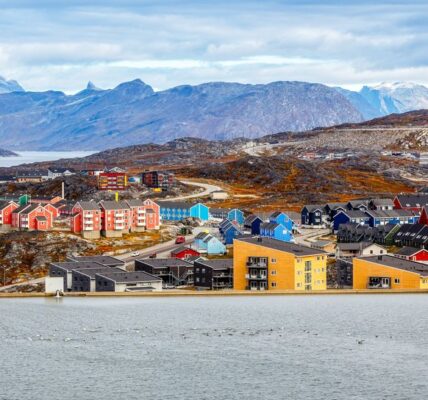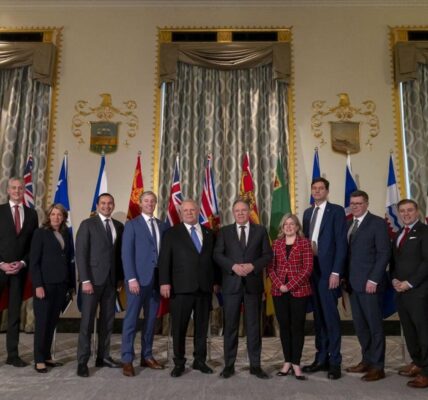Under the slogan “High North, low tension,” Arctic cooperation between Russia and its Nordic neighbors was, for a long time, widely shielded from the consequences of Russia’s military campaigns against Georgia, Ukraine (in 2014), and Syria. However, the 2022 full-scale invasion of Ukraine finally led to a halt of regional cooperation.
For Russia, the Arctic is essential for military and economic reasons. Its Northern Fleet, with nuclear-capable submarines, is located in the Arctic, as well as 80 percent of the country’s natural gas and 17 percent of its oil production. The Northern Sea Route is becoming increasingly relevant as a connection to Asian markets, which Russia needs to counterbalance Western sanctions.
Going forward, Russia’s Western neighbors must become increasingly careful about resuming cooperation with Russia. While joint efforts to tackle environmental hazards—such as the nuclear waste Russia has been dumping off its Arctic coast since Soviet times—would be desirable, Russia has a track record of covertly using cooperation formats to advance its own geopolitical interests.
For a long time, the Arctic was seen as a zone free of geopolitical tensions. Apart from joint military drills between NATO members and Russia that were discontinued after Russia’s annexation of Crimea, “High North, low tension” was the Norwegian slogan under which “softer” forms of Arctic cooperation continued. This cooperation persisted despite Russia’s invasion of Georgia in 2008, annexation of Crimea 2014, and military campaigns in support of the Assad regime in Syria. After all, half of the Arctic region is in Russian territory, so there is only half a point in Arctic cooperation without Russia, especially on global issues such as climate change and environmental degradation. But with Russia’s full-scale war of aggression against Ukraine in 2022, most cooperation formats have now been put indefinitely on hold.
Russia’s Arctic Assets
A closer look reveals, however, that tensions had been growing in the Arctic well before 2022 due to Russia’s military build-up and increasing “show-of-force” exercises. Russia’s latest military drill in and around the Kola Peninsula, including extensive submarine action that worries NATO most, took place in mid-April 2023. In the past decade, Russia has rebuilt almost all of its Soviet-era Arctic military bases close to its Western border. According to Reuters and the International Institute of Strategic Studies, Russia outnumbers NATO in terms of military bases in the Arctic region by one-third. The nuclear-capable submarines in the Northern Fleet constitute Russia’s main second-strike capability, around which it has built the Soviet-inspired “Bastion defense.” To underline the significance of the Northern Fleet, it was made its own military district in 2021.
Apart from the eight ballistic missile submarines, the capabilities located in the Northern Fleet Military District also include nineteen attack submarines, two cruisers, seven destroyers and frigates, sixteen patrol boats, eight mine countermeasure ships, eight landing ships, and an aircraft carrier currently under repair. The 45th air and air defense army, 14th army corps, and coastal forces are also located in the Northern Fleet Military District. Russia has been investing heavily in its submarine capabilities in the Arctic. In the summer of 2022, it introduced a new Belgorod-type submarine that can carry Poseidon torpedoes with nuclear warheads and can sneak past coastal defenses close to the seabed.
Why Does the Arctic Matter?
For Russia, the Arctic is an essential area of interest not only in terms of national security but also for economic reasons. Russia’s hydrocarbon sector depends on Arctic resources: they account for 80 percent of Russia’s natural gas and 17 percent of its oil production. Safeguarding its interests along the Northern Sea Route (NSR)—now more accessible due to climate change—is a high priority for Russia. The route is particularly important for Russia’s energy exports—such as liquified natural gas (comprising 64 percent of total cargo volume in 2020 and currently growing, as it is not subject to Western sanctions yet), oil and petroleum products, coal, and iron—to both Europe and Asia. However, Russia’s 2022 invasion of Ukraine halted traffic on the NSR for a while. Likewise, prospects of major energy infrastructure projects (e.g., Rosneft’s plans to construct one of the world’s largest oil loading terminals) are currently uncertain due to Russia’s increasing international isolation.
Russia needs to secure year-round navigability of the NSR to access markets in the East, which are now more important given Western sanctions. As a result, the country is investing in an increasing number of nuclear-powered icebreakers. The future of Russia’s Arctic resource exploitation will depend to a large extent on how the nation’s relationship with China develops and whether Russia can secure India as a customer. The current prospects look promising on both accounts.
A Nuclear Time Bomb
Both Russia’s military posture in the Arctic, centering on its submarine nuclear capabilities that are essential for its global power projection, and Russia’s economic interests in the NSR, which require year-round navigability secured by nuclear-powered icebreakers, contribute to a long-term side effect: radioactive waste. In addition to the waste from domestic nuclear use, in 2001, Russia changed its legislation to allow imports of spent nuclear fuel from other countries, for a lucrative estimated sum of $20 billion over ten years. The plan, criticized by Russia’s own nuclear supervisory state agency at the time due to concerns about the handling of domestically-produced waste to begin with, led Rosatom to halt imports in 2009. This occurred after it was revealed that the depleted uranium had been stored in inadequately secured containers. Nuclear waste imports resumed a decade later from Germany, under a new reuse scheme that made the otherwise illegal shipping possible.
Russia has a long history of sloppy storage of radioactive waste. During the Cold War, the Soviet Union considered its Arctic coastline a suitable dumping ground for radioactive waste, as especially the Kara Sea in the Novaya Zemlya archipelago used to stay frozen most of the year and had no commercial traffic. From the late 1960s until 1980s, around 18,000 radioactive objects were disposed of in Arctic coastal waters. The Novaya Zemlya archipelago was used as a nuclear bomb testing site in Soviet times. The waste dumps there consist mostly of spent nuclear fuel of decommissioned submarines, but it also includes nuclear reactors and two submarines, one sunk purposefully in the 1980s and another lost accidentally while being towed in 2003. While recent studies and diving expeditions have not found evidence of acute leakages, the sealant of the nuclear reactor in the submarine sunk on purpose in the 1980s was only estimated to last fifty years, meaning that it could start leaking in the next decade. The other submarine that sank accidentally has no sealant systems in place for the 800 kg spent uranium fuel on board.
During its chairmanship of the Arctic Council in 2021, Russia had announced plans to lift the most urgent high-liability nuclear waste items from its Arctic waters by 2035. But now, with international cooperation halted over Russia’s invasion of Ukraine, it is increasingly dubious that Russia has both the financial and technical means—and willingness—to conduct the operation alone. And time is running out, as the feasibility of a lifting operation decreases when the radioactive objects increasingly disintegrate over time. The environmental threat posed by nuclear waste adds a layer of complexity to the already difficult Arctic equation for Russia’s northwestern neighbors Finland and Norway.
End of Western Wishful Thinking
While the Northern European Arctic states—Norway, Sweden, and Finland—have been eager to cooperate with Russia in the Arctic in good faith, Russia has used the narrative of “Arctic exceptionalism” and framing the region as a zone of low tensions as a screen for its military build-up. Russia has also been able to get away with actions directly threatening the safety of the wider region, while its Nordic neighbors have kept extending a helping hand. In 2021, the European Union offered to bear half of the cost of an operation to lift the two nuclear submarines that Russia has sunk in the Barents and Kara Sea. Previously, Sweden and Norway had provided substantive financial support for equipping the Russian ship Serebryanka to tackle the nuclear waste issue. Russia, however, ended up using the vessel in a nuclear testing and developing program.
With the European security order in pieces, there is no reason to expect the Arctic to remain a zone of peace, safely secluded from growing geopolitical tensions elsewhere. A recent Finnish government-commissioned study assesses the security outlook in the European Arctic as bleak, with Putin’s regime survival directly linked to the military-strategic value and energy resources of the region. The trust basis for cooperation with Russia has eroded, even if Russia’s stated strategic objectives for the Arctic do not necessarily change in the future. Its smaller Nordic neighbors must become increasingly cautious about resuming cooperation with Russia, as Russia could use such frameworks against their interests.
NATO’s New Arctic Dimension
So far, the Arctic has been kept largely out of NATO’s reach, as the regional allies Norway and Canada considered it the best approach. But with Finland now NATO’s thirty-first member, and Sweden hopefully following suit soon, the Arctic inevitably becomes a relevant sphere for NATO. From the alliance’s perspective, the North Atlantic and Arctic waters are crucial for delivering reinforcements from North America to the European Arctic. In a conflict, securing allied freedom of navigation in the Greenland-Iceland-United Kingdom (GIUK) gap would be key for NATO—and cutting off Northern American allies from Europe by disrupting the GIUK line would be equally important for Russia.
The Finnish-Swedish NATO accession changes the situation fundamentally for founding member Norway, which has hitherto been the sole gatekeeper of the High North within NATO. To manage relations with Russia, Norway—which shares a short border with Russia in the Arctic—has followed a dual-track approach: deterrence and reassurance, or “calibrated deterrence.” Deterrence has been provided by Norway’s NATO membership, while reassurance measures have included self-restraint in conducting NATO military drills in the northern parts of the country close to the border with Russia. Norway, however, started to increase its own military presence in its northernmost region Finnmark already in 2017, as a response to Russia’s annexation of Crimea in 2014. Russia’s 2022 full-scale war against Ukraine has triggered further recalibration of Norway’s deterrence: American troops were exercising demonstratively in northern Norway in November 2022.
Russia has been framing its military posture in the Arctic as defensive. However, it has invested heavily in dual-capable weapons and carried out simulated attacks on neighbors during exercises, such as against Sweden in 2013, which was a simulated nuclear attack according to a NATO report. Russia’s “deterrence by intimidation” strategy and zero-sum understanding of security require its Western neighbors—and NATO—to increase their military presence in the Arctic as well, “to maintain the Arctic balance,” as Norway’s Chief of Navy Rune Andersen told Finnish media during the recent Joint Viking exercise with NATO partners. Now that the alliance is reconfiguring its deterrence posture on the northeastern flank, it is vital to view the wider Baltic Sea-North Atlantic-Arctic region as a coherent area and make sure no ambiguity is left that can be exploited—or misunderstood—by Russia.




